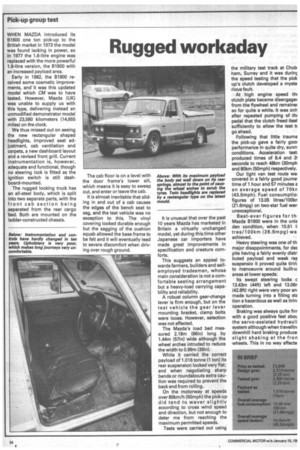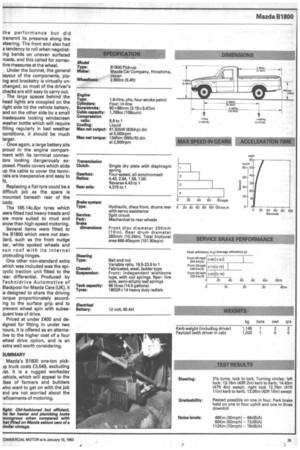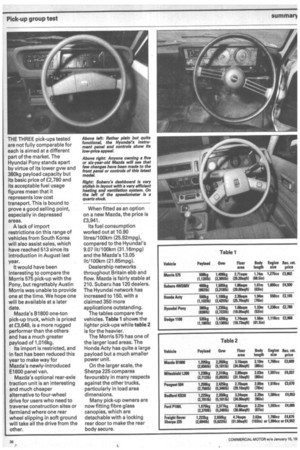Rugged workaday
Page 36

Page 37

Page 38

If you've noticed an error in this article please click here to report it so we can fix it.
WHEN MAZDA introduced its B1600 one ton pick-up to the British market in 1973 the model was found lacking in power, so in 1977 the 1.6-litre engine was replaced with the more powerful 1.8-litre version, the B1800 with an increased payload area.
Early in 1982, the B1800 received some cosmetic improvements, and it was this updated model which CM was to have tested. However, Mazda (UK) was unable to supply us with this type, delivering instead an unmodified demonstrator model with 23,580 kilometers (14,655 miles) on the clock.
We thus missed out on seeing the new rectangular shaped headlights, improved seat adjustment, cab ventilation and carpets, a new dashboard layout and a revised front grill. Current instrumentation is, however, adequate and functional, though no steering lock is fitted as the ignition switch is still dashboard-mounted.
The rugged looking truck has an all-steel body, which is split into two separate parts, with the front cab section being separated from the rear cargo bed. Both are mounted on the ladder-constructed chassis. The cab floor is on a level with the door frame's lower sill, which means it is easy to sweep out, and enter or leave the cab.
It is almost inevitable that sliding in and out of a cab causes the edges of the bench seat to sag, and the test vehicle was no exception to this. The vinyl covering looked durable enough but the sagging of the cushion squab allowed the base frame to be felt and it will eventually lead to severe discomfort when driving over rough ground. It is unusual that over the past 10 years Mazda has marketed in Britain a virtually unchanged model, yet during this time other Japanese car importers have made great improvements in specification and creature comforts.
This suggests an appeal towards farmers, builders and selfemployed tradesmen, whose main consideration is not a comfortable seating arrangement but a heavy-load carrying capability and reliability.
A robust column gear-change lever is firm enough, but on the test vehicle the gear lever mounting bracket, clamp bolts were loose. However, selection was not affected.
The Mazda's load bed measured 2.18m (86in) long by 1.44m (571n) wide although the wheel arches intruded to reduce the width to 0.99m (39in)..
While it carried the correct payload of 1.016 tonne (1 ton) its rear suspension looked very flat; and when negotiating sharp bends or roundabouts extra caution was required to prevent the back end from rolling.
On the motorway at speeds over 80km/h (50mph) the pick-up did tend to waver slightly according to cross wind speed and direction, but not enough to deter me from reaching the maximum permitted speeds.
Tests were carried out using the military test track at Chob. ham, Surrey and it was durinc the speed testing that the pick up's clutch developed a myste rious fault.
At high engine speed tho clutch plate became disengage( from the flywheel and remainec so for quite a while. It was onh after repeated pumping of filo pedal that the clutch freed itsel sufficiently to allow the test t( go ahead.
Following that little trauma the pick-up gave a fairly goo( performance in quite dry, sunry conditions. Acceleration test: produced times of 8.4 and 21 seconds to reach 48km (30mph and 80km (50mph) respectively.
Our light van test route war covered in a fairly good journe time of 1 hour and 57 minutes a an average speed of 70kn (43.5mph). Fuel consumptioi figures of 13.05 litres/100kn (21.6mpg) on two-star fuel wen unexceptional.
Best-ever figures for 01 Mazda B1800 were in the unla den condition, when 10.51 Ii tres/1 00km (2 6.9mpg) wa achieved.
Heavy steering was one of th, major disappointments, for des pite having a fairly evenly distri buted payload and weak rea suspensio it proved quite tirin, to manoeuvre around built-4 areas at lower speeds.
Its swept steering locks c 13.43m (44ft) left and 13.06n (42.8ft) right were very poor an made turning into a filling sta tion a hazardous as well as tirini operation.
Braking was always quite firr with a good positive feel aboi the servo-assisted hydrauli system although when travellin, downhill hard braking produce slight shaking at the fron wheels. This in no way affecte
the performance but did transmit its presence along the steering. The front end also had a tendency to roll when negotiating bends on uneven surfaced roads, and this called for corrective measures at the wheel.
Under the bonnet, the general layout of the components, piping and bracketry is virtually unchanged, so most of the driver's checks are still easy to carry out.
The large spaces behind the head lights are occupied on the right side 0 the vehicle battery, and on the other side by a small inadequate looking windscreen washer bottle which will require filling regularly in bad weather conditions, it should be much larger.
Once again, a large battery sits proud in the engine compartment with its terminal connectors looking dangerously exposed. Plastic covers which slide up the cable to cover the terminals are inexpensive and easy to Replacing a flat tyre could be a difficult job as the spare is mounted beneath rear of the body.
The 185.14c.8pr tyres which Nere fitted had heavy treads and are more suited to mud and snow than high-speed motoring.
Several items were fitted to :he B1800 which were not standard, such as the front nudge bar, white spoked wheels and sun roof with its internal protruding hinges.
One other non-standard extra which was included was the
traction unit fitted to the -ear differential. Produced by rechnidrive Automotive of Blackpool for Mazda Cars (UK), it Is designed to share the driving torque proportionately according to the surface grip and to prevent wheel spin with subsewent loss of drive.
Priced at under £400 and designed for fitting in under two hours, it is offered as an alternative to the higher cost of a four Nheel drive option, and is an axtra well worth considering.
3LIMMARY
Mazda's B1800 one-ton pickip truck costs £3,649, excluding rat. It is a rugged workaday rehicle, which will appeal to the ikes of farmers and builders Nho want to get on with the job 3nd are not worried about the -efinements of motoring. THE THREE pick-ups tested are not fully comparable for each is aimed at a different part of the market. The Hyundai Pony stands apart by virtue of its lower gvw and 380kg payload capacity but its basic price of £2,780 and its acceptable fuel usage figures mean that it represents low cost transport. This is bound to prove a good selling point, especially in depressed areas.
A lack of import restrictions on this range of vehicles from South Korea will also assist sales, which have reached 513 since its introduction in August last year.
It would have been interesting to compare the Morris 575 pick-up with the Pony, but regrettably Austin Morris was unable to provide one at the time. We hope one will be available at a later date.
Mazda's B1800 one-ton pick-up truck, which is priced at £3,649, is a more rugged performer than the others and has a much greater payload of 1,016kg.
Its import is restricted, and in fact has been reduced this year to make way for Mazda's newly-introduced E1600 panel van.
Mazda's optional rear-axle traction unit is an interesting and much cheaper alternative to four-wheel drive for users who need to traverse construction sites or farmland where one rear wheel slipping in soft ground will take all the drive from the other. When fitted as an option on a new Mazda, the price is £3,941.
Its fuel consumption worked out at 10.90 litres/100km (25.92mpg), compared to the Hyundai's 9.07 lit/100km (31.16mpg) and the Mazda's 13.05 lit/100km (21.65mpg).
Dealership networks throughout Britain ebb and flow. Mazda is fairly stable at 210. Subaru has 120 dealers. The Hyundai network has increased to 150, with a claimed 350 more applications outstanding.
The tables compare the vehicles. Table 1 shows the lighter pick-ups while table 2 is for the heavier.
The Morris 575 has one of the larger load areas. The Honda Acty has quite a large payload but a much smaller power unit.
On the larger scale, the Sherpa 225 compares favourably in many respects against the other trucks, particularly in load area dimensions.
Many pick-up owners are now fitting fibre glass canopies, which are detachable with a locking rear door to make the rear body secure.








































































































